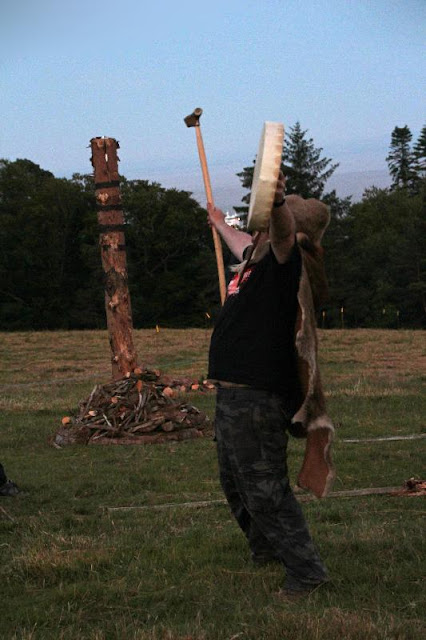Burning the Circle is both the name given to the weekend-long experiemental archaeology event at Brodick Castle, and a description of the final event. On the Sunday night the post circle was set alight.
The idea behind this was partly to be able to discover things like how easy/difficult it was to set the circle alight, how long the posts would burn for, would they burn right away, etc - and perhaps in a few years the site can be excavated to see what kind of evidence is left behind to show that there was ever a post circle there. But it was also to see the effect on the people who witnessed the burning.
Both from talking to archaeologists in Orkney and elsewhere, and from witnessing this event, it seems clear that the act of putting up and burning down these circles were almost as important, if not more so, than any ceremonial use they were put to when they were standing. This is also tru for erecting some of the famous stone circles, such as the Ring of Brodgar. When you see the rock cut ditch around it, as well as realise where the stones have come from, it's obvious that erecting it was something special in itself and would have taken possibly many decades, or generations, to do. The post circle was the same - it seemed as if burning it was harder work than erecting it in the first place, and certainly had a huge impact on those who witnessed it. I'd say that the burning would live on in the fok memory for an awful lot longer than witnessing its erection would do.
The whole event was extremely well organised, if poorly attended - disappointingly so as far as I was concerned. My 2nd criticism (I mentioned the first, the lack of advertising for the event, in an earlier post) was the health and safety gone mad bit of them doing a health and safety briefing at the start of the burning event including telling us where to "assemble" in the event of the fire getting out of control. Em ... this was an event in the middle of an open field. If the fires got so fierce they asked us to evacuate the area we'd simply get into the car and go home, rather than hang about a building near the car park. It's not as if there was a head count anyway!! So the heath-and-safety-gone-mad type briefing seemed a little over-the-top, to say the least. But I guess that's one of the things they had to do to be allowed to run a public event like this.


Anyway, the organisation really was fantastic, right down to the trail of (battery operated) candles running from the ranger centre right up the path to the post circle up in a field abov the bronze age roundhouse. At the start of the event we were given a short talk about why it was taking place, which helped set the scene, especially for those people (if there were any) who hadn't been at the daytime events.
Then the circle was set alight...

Another quick 'health and safety moment' as the fire resistant gloves are donned...
Watching the posts burn was quite mesmerising...
... and the haunting sound of the horn drifting across the circle and across towards Brodick added to the sense of occasion.
I could have watched the fires burn all night...
The central post had a head craved onto it, by local carver Marvin Elliott (in a kayaking link, for my kayaking readers, he's the person who carved the Corrie Seal, seen
here in Douglas Wilcox's excellent blog.)
Sadly, time was ticking on and we decided to leave the circle burning fiercely below Goatfell...
... and head off along to Brodick to see how well it could be seen across the bay.
We were amazed at how clearly it could be seen, to the left if the floodlit castle.
We then stopped at the top of the Lamlash hill, about 3 miles away from the burning circle, and it could still be much more clearly seen in person than in the photo.
Here it is, again to the left of the floodlit Castle, photographed from about 3 miles away.
It just shows that an event like this could have an impact across a large area in broze age times. It could clearly be seen - and no doubt if there had been music and dancing that would have been heard across a large distance, especially on a clear night.
The next day, from the ferry, I photographed what could be seen of the circle. It looked like a lot was still standing and it made me very aware of the amount of work which must go into burning a monument like this down completely, so that the posts are gone and all that remains is burnt remains for archaeologists to dig up centruies, or millenia, later...
Overall, this was an absolutely fantastic event and I hope I'm lucky enough to get the chance to participate in something like this again in the future.

















































